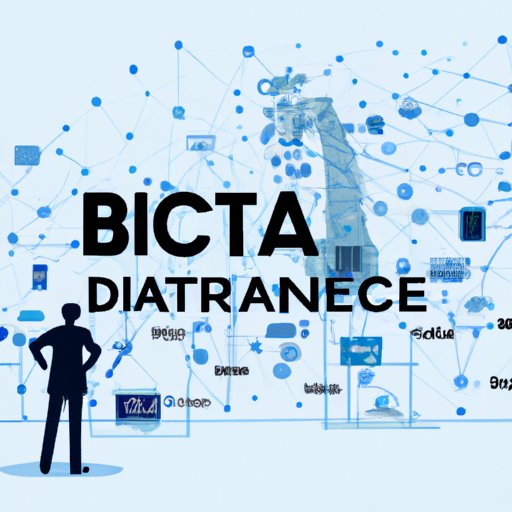Introduction
Big data science is a term used to describe the process of collecting, analyzing and interpreting large sets of data in order to gain insights and draw conclusions. It is an increasingly important area of research and development, as organizations seek to understand and make use of the vast amounts of data they generate and collect. In this article we will explore the basics of big data science, its benefits, its challenges and opportunities, and the potential future trends.
Exploring the Basics of Big Data Science
Before we can begin to examine the benefits, challenges and opportunities of big data science, we must first understand what it is and how it works. In this section, we’ll look at the components of big data and the different types of data that are used in big data science.
What is Big Data?
Big data is a term used to describe large sets of data that are too complex or too large to be managed by traditional data processing methods. The data is typically collected from multiple sources and is often unstructured, meaning it does not fit into traditional data models. Big data is often characterized by its three key features: volume, velocity and variety.
Understanding the Components of Big Data
In order to effectively manage and analyze big data, it is important to understand the various components of big data. These components include data storage, data processing, data analysis, and data visualization. Data storage refers to the systems used to store large amounts of data, such as databases and cloud-based services. Data processing involves transforming raw data into a form that can be analyzed. Data analysis involves applying algorithms and statistical methods to identify patterns and correlations in the data. Finally, data visualization involves creating visual representations of the data in order to better understand it.
Examining Different Types of Data
Big data science relies on many different types of data. Structured data is data that has been organized into a standard format, such as tables and columns. Unstructured data is data that does not have a predefined structure, such as text documents and images. Semi-structured data is data that has some structure, but not a fully defined one, such as XML files. Finally, machine-generated data is data generated by machines, such as sensor readings and web logs.
Understanding the Tools and Technologies of Big Data Science
In order to effectively manage and analyze big data, it is important to understand the various tools and technologies that are used for big data science. In this section, we will examine the key tools used in big data science, explain how these tools work, and discuss the benefits of using these tools.
Listing the Key Tools Used in Big Data Science
The most common tools used in big data science are Apache Hadoop, Apache Spark, Apache Kafka, and Apache Cassandra. Apache Hadoop is an open-source framework for distributed storage and processing of large datasets. Apache Spark is an open-source big data analytics engine. Apache Kafka is a distributed streaming platform for handling real-time data feeds. Apache Cassandra is a distributed database management system.
Explaining How These Tools Work
These tools work together to enable the efficient storage, processing and analysis of large datasets. Apache Hadoop is used for storing and processing large datasets. Apache Spark is used for running distributed batch jobs and stream processing tasks. Apache Kafka is used for ingesting and streaming data. Apache Cassandra is used for managing and querying large datasets.
Discussing the Benefits of Using These Tools
Using these tools has many benefits. They allow for faster and more efficient storage and processing of large datasets. They enable distributed computing, which makes it possible to process and analyze large datasets in parallel. They also provide scalability, allowing organizations to easily add more computing power as needed. Finally, they are cost-effective, making it possible to process large datasets without expensive hardware.
Examining the Benefits of Big Data Science
Now that we have explored the basics of big data science, let us examine the benefits that it offers. In this section, we will look at how big data science can enhance business efficiency, improve decision making, and increase productivity.
Enhancing Business Efficiency
Big data science can help businesses become more efficient by providing insights into their operations. By collecting and analyzing data from various sources, businesses can identify areas where processes can be improved, resources can be allocated more efficiently, and decisions can be made more quickly and accurately. This can lead to increased efficiency and cost savings.
Improving Decision Making
Big data science can also help businesses make better decisions. By collecting and analyzing data from various sources, businesses can gain insights into customer behavior, market trends, and other factors that can influence their decisions. This can help businesses make more informed decisions that are based on data rather than guesswork.
Increasing Productivity
Big data science can also help businesses increase their productivity. By collecting and analyzing data from various sources, businesses can identify areas where processes can be streamlined and automated. This can lead to increased productivity and cost savings.

Analyzing Case Studies in Big Data Science
In order to better understand the impact of big data science, let us examine some case studies. In this section, we will look at some success stories, examine different industries, and assess the impact of big data science.
Identifying Success Stories
There are numerous success stories of companies that have used big data science to improve their operations. For example, Walmart used big data science to optimize its inventory management and reduce costs. Netflix used big data science to develop personalized recommendations for its users. Amazon used big data science to improve its supply chain and delivery times. These are just a few examples of how big data science can be used to improve operations.
Examining Different Industries
Big data science has been used in many different industries. It has been used in healthcare to improve patient outcomes, in retail to optimize inventory management, in finance to improve risk management, and in manufacturing to optimize production. These are just a few examples of how big data science can be used to improve operations in different industries.
Assessing the Impact of Big Data Science
Overall, the impact of big data science has been positive. It has enabled businesses to become more efficient and productive, and to make better decisions. It has also enabled them to gain valuable insights into their operations and the markets they operate in. Ultimately, big data science has helped businesses gain a competitive edge and improve their bottom line.

Investigating Challenges and Opportunities in Big Data Science
Although big data science offers many benefits, there are also some challenges and opportunities associated with it. In this section, we will examine the challenges and opportunities of big data science.
Recognizing the Challenges
One of the main challenges of big data science is privacy. As organizations collect and analyze large amounts of data, they must ensure that the data is secure and that any personal information is kept confidential. In addition, due to the complexity of the data and the tools used to analyze it, there is a risk of errors. Finally, the cost of implementing and maintaining big data solutions can be high.
Exploring Possible Solutions
To address these challenges, organizations should invest in secure data storage solutions and implement strict security protocols. They should also invest in training and education for their employees to ensure that they understand the complexities of the data and the tools used to analyze it. Finally, they should carefully evaluate their needs before investing in big data solutions to ensure that they are getting the most value for their money.
Examining Opportunities in Big Data Science
Despite the challenges, there are also many opportunities associated with big data science. Organizations can use big data to gain valuable insights into their operations, identify new opportunities, and develop innovative products and services. Big data can also be used to improve customer experience and increase sales. Finally, big data can be used to optimize processes and reduce costs.

Looking at the Future of Big Data Science
As big data science continues to evolve, it is important to consider the potential future trends. In this section, we will look at some potential future trends and applications.
Predicting Trends in Big Data Science
One trend that is likely to continue is the growth of cloud computing. As organizations move towards cloud-based solutions, they will be able to take advantage of the scalability and cost-effectiveness of cloud computing. In addition, artificial intelligence and machine learning are likely to become more commonplace, as organizations use these technologies to automate processes and gain insights from their data. Finally, predictive analytics is likely to become more popular, as organizations use predictive models to anticipate customer needs and trends.
Examining Emerging Technologies
Another trend that is likely to emerge is the use of blockchain technology. Blockchain technology can be used to securely store and share data, making it ideal for use in big data science. In addition, edge computing is likely to become more popular, as organizations use this technology to process data closer to the source. Finally, natural language processing is likely to become more common, as organizations use this technology to gain insights from unstructured data.
Examining Applications of Big Data Science
Finally, big data science is likely to be used in many different applications. It can be used to detect fraud, optimize supply chains, improve healthcare outcomes, and much more. As organizations continue to adopt big data science, the applications and possibilities are likely to become even more diverse.
Conclusion
In conclusion, big data science is an increasingly important area of research and development. It enables organizations to collect, analyze, and interpret large sets of data in order to gain insights and draw conclusions. It is used in many different industries, and offers many benefits, such as enhanced business efficiency, improved decision making, and increased productivity. However, it is also associated with some challenges, such as privacy concerns and the cost of implementation. Despite these challenges, there are many opportunities associated with big data science, and the potential applications are likely to become even more diverse in the future.
(Note: Is this article not meeting your expectations? Do you have knowledge or insights to share? Unlock new opportunities and expand your reach by joining our authors team. Click Registration to join us and share your expertise with our readers.)
